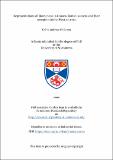Files in this item
Representations of Idomeneus in Graeco-Roman sources and their reception in the West, to 1720
Item metadata
| dc.contributor.advisor | Hesk, Jon | |
| dc.contributor.advisor | Buckley, Emma | |
| dc.contributor.author | McLaren, Colin Andrew | |
| dc.coverage.spatial | xi, 228 p. | en_US |
| dc.date.accessioned | 2020-06-18T15:35:43Z | |
| dc.date.available | 2020-06-18T15:35:43Z | |
| dc.date.issued | 2020-07-30 | |
| dc.identifier.uri | https://hdl.handle.net/10023/20103 | |
| dc.description.abstract | The dissertation examines representations of Idomeneus, and of the myths and traditions associated with him, in Graeco-Roman literature, and their reception in the West (represented by Italy, France, Germany and England). It takes the following form: Chapter 1, the representations and their cultural significance; Chapter 2, the representation of Idomeneus in the Iliad; Chapter 3, accretive representations of Idomeneus, principally from Late Antiquity; Chapter 4, the transmission of the accretive representations to the West, their accessibility through vernacular translation and their assimilation in contemporary literature; Chapter 5, the transmission of the Iliadic representation of Idomeneus to the West, through the publication of the epic, first in an academic format, latterly as polite literature; Chapter 6, the association of Iliadic and accretive representations in literature and drama between 1699 and 1720; Chapter 7, summary and conclusion. The dissertation addresses hitherto under-explored issues in the representation of Idomeneus. These include his limitations as an aristos in the Iliad; his gradual detachment from his associate, Meriones; his prominence in the English ‘interlude’, Horestes (1567); his treatment in Italian and French burlesque of the seventeenth and eighteenth centuries; his representation in fin-dix-septième French drama; and in Alexander Pope’s enlightened character study of 1720. These are supplemented by assessments of the impact of authorial/editorial omissions, paraphrases and interpolations on the representations; and of Idomeneus’ visibility in text, paratext and early ‘books of reference’, compared with that of his fellow-aristoi, the Aiantes, Diomedes, Nestor and Odysseus. | en_US |
| dc.language.iso | en | en_US |
| dc.subject | Classical reception | en_US |
| dc.subject | Classical tradition | en_US |
| dc.subject | Classical literature in translation | en_US |
| dc.subject.lcc | BL820.I37M36 | |
| dc.subject.lcsh | Idomeneus (Greek mythology) | en |
| dc.subject.lcsh | Idomeneus (Greek mythology) in literature | en |
| dc.subject.lcsh | Classical literature--Influence | en |
| dc.subject.lcsh | Classical literature--Translations--History and criticism | en |
| dc.title | Representations of Idomeneus in Graeco-Roman sources and their reception in the West, to 1720 | en_US |
| dc.type | Thesis | en_US |
| dc.type.qualificationlevel | Doctoral | en_US |
| dc.type.qualificationname | PhD Doctor of Philosophy | en_US |
| dc.publisher.institution | The University of St Andrews | en_US |
| dc.rights.embargoreason | Embargo period has ended, thesis made available in accordance with University regulations | en |
| dc.identifier.doi | https://doi.org/10.17630/10023-20103 |
This item appears in the following Collection(s)
Items in the St Andrews Research Repository are protected by copyright, with all rights reserved, unless otherwise indicated.

